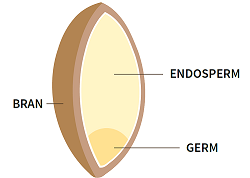What are wholegrains?

Why do we need wholegrains?
Wholegrain products have many nutritional benefits other than their high fibre content. Although this is the most obvious benefit as it helps move our food through our digestive system. Products high in fibre keep your bowels healthy and keep you fuller for longer. But they are also packed full of B vitamins, essential fatty acids, and antioxidants, providing a lot more nutritional benefit than white carbohydrates. The bacteria in our guts ferment the fibre that we eat to make molecules that benefit our body and brain. Wholegrains are very helpful to our immune systems and can reduce inflammation in our guts due to the beta-glucans they contain.
What’s the recommended wholegrain intake?
Children aged 2-4:
- It’s good practice to provide wholegrains foods for at least one breakfast, lunch and dinner each week.
- Young children can have wholegrains but should eat mostly white carbohydrates as wholegrain ones can be too filling for children this age.
- From age 2, children should have 15g of fibre per day.
Children aged 5+:
- From age 5 onwards children’s diets should follow the Eatwell Guide and their meals should be based on wholegrain starchy carbohydrates.
- When increasing a person’s fibre intake it is important to also remember to increase their fluid intake to prevent constipation.
- It is recommended that primary school aged children have 20g of fibre per day.
Adults:
- Adults should have approximately 260g of carbohydrates a day and at least 30g of fibre.
How can we encourage children to eat wholegrains?
Many of your child’s favourite foods will have wholegrain alternative to make small swaps without them noticing. When doing the family food shop, choose the wholegrain varieties instead of the refined white varieties. Use our top tips below for easy swaps you can make to get wholegrains into your everyday meals!
Breakfast:
- Have wholegrain cereals or oats with milk or yoghurt, topped with fruit.
- Swap out your white bread, pitta breads, wraps and crackers for wholegrain ones.
Lunch and dinner:
- When cooking, try using brown rice or pasta as an alternative to white.
- Use up leftovers to make soups and salads for lunch
Snacks:
- Opt for wholegrain cereal bars, oats cakes, rice cakes and plain popcorn. These can be topped with fruit or nut butters.
- Swapping to 50/50 bread can be a good step in the right direction if your child doesn’t want to eat wholegrain bread straight away.
For more recipe ideas using wholegrain ingredients, check out some of our PhunkyFoods recipes.


